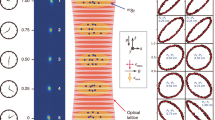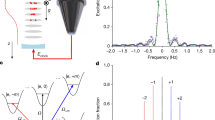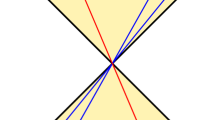Abstract
It is a direct consequence of the Einstein equivalence principle (EEP) that all atomic clocks will run at the same rate if situated at the same point in space-time. This prediction of a universal gravitational redshift is a property of any self-consistent metric theory of gravity1. The class of experiments considered here essentially involves a comparison of two clocks, one of which is a quartz crystal stabilized to a caesium-beam atomic frequency standard, and the other, more important for this discussion, is a NMR clock, for which the ‘ticks’ are provided by the free precession of a sample of polarized nuclear spins in a stable and uniform magnetic field. Two experimental null results have been reported, one by Hughes2 and the other by Drever3. We point out that some measurements already exist for spin 1/2 systems which can put tighter limits on anisotropic precession frequencies than the Hughes–Drever results, and we suggest an experimental technique that should allow a further improvement in precision by up to six orders of magnitude. Apart from the interest to gravitation physics these results are also important for high precision metrology and the provision of standards of magnetic flux density and electric current.
This is a preview of subscription content, access via your institution
Access options
Subscribe to this journal
Receive 51 print issues and online access
$199.00 per year
only $3.90 per issue
Buy this article
- Purchase on Springer Link
- Instant access to full article PDF
Prices may be subject to local taxes which are calculated during checkout
Similar content being viewed by others
References
Will, C. M. Theory and Experiment in Gravitational Physics (Cambridge University Press, 1981).
Hughes, V. W., Robinson, H. G. & Beltran-Lopez, V. Phys. Rev. Lett. 4, 342–344 (1960).
Drever, R. W. P. Phil. Mag. 6, 683–687 (1961).
Cocconi, G. & Salpeter, E. Nuovo Cimento 10, 647–651 (1958).
Dicke, R. H. The Theoretical Significance of Experimental Relativity (Blackie and Son, London, 1964).
Hari Dass, N. D. Phys. Rev. Lett. 36, 393–395 (1976).
Golub, R. Inst Phys. Conf. Ser. 42, 104–106 (1978).
Velyukhov, G. E. JETP Lett. 8, 229–231 (1968).
Arlen Young, B. Phys. Rev. Lett. 22, 1445–1446 (1969).
Williams, E. R. & Olsen, P. T. Phys. Rev. Lett. 42, 1575–1579 (1979).
Vigoureux, P. NPL Rep. DES–44 (National Physical Laboratory, Teddington, 1978).
Weichuan, C., Ruimin, L. & Pingi, S. IEEE Trans. Inst. Meas. IM– 29, 238–242 (1980)
Cohen-Tannoudji, C., DuPont–Roc, J., Haroche, S. & Laloe, F. Phys. Rev. Lett. 22, 758–760 (1969).
Gallop, J. C. & Radcliffe, W. R. J. Phys. D11, L203–205 (1979).
Gallop, J. C. & Radcliffe, W. R. J. Phys. E14, 461–463 (1981).
Peebles, P. J. E. Ann. Phys. 20, 240–260 (1964).
Karwacki, F. A. Navigation 27, 72–78 (1980).
Petley, B. W. in Precision Measurement and Fundamental Constants (eds Cutler, P. & Lucas, A.) (NATO–ASI Series, Plenum, New York, in the press).
Cohen, E. R. & Tayor, B. N. J. Phys. Chem. Ref. Data 2, 663–744 (1973).
Potts, S. P. & Preston, J. J. navig. Sci. 6, (1980).
Raine, D. J. Rep. Prog. Phys. 14, 1152–1195 (1981).
Canuto, V. M. & Goldman, I. Nature 296, 709–712 (1982).
Author information
Authors and Affiliations
Rights and permissions
About this article
Cite this article
Gallop, J., Petley, B. Gravitational anisotropies of gyromagnetic ratios and tests of general relativity. Nature 303, 53–54 (1983). https://doi.org/10.1038/303053a0
Received:
Accepted:
Issue Date:
DOI: https://doi.org/10.1038/303053a0
Comments
By submitting a comment you agree to abide by our Terms and Community Guidelines. If you find something abusive or that does not comply with our terms or guidelines please flag it as inappropriate.



